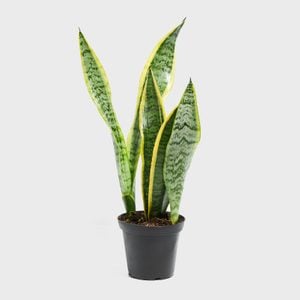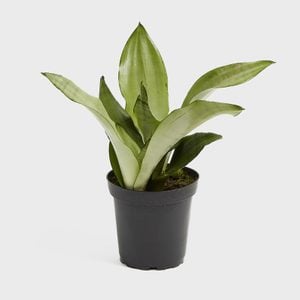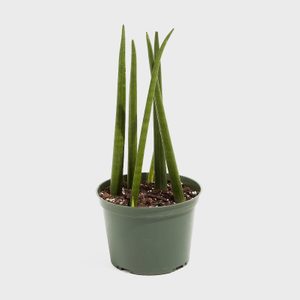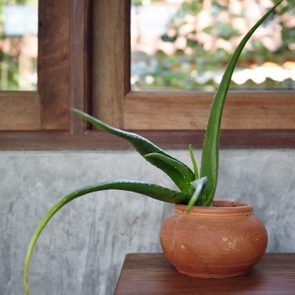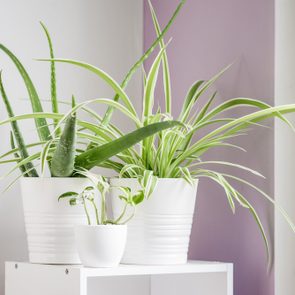How to Care for Snake Plants
Updated: Jan. 05, 2023

Want a houseplant but not sure you have a green thumb? Choose a hard-to-kill plant, like a snake plant. Here's how to take care of one.
Whether you’re looking to add to your collection of indoor plants or you’re new to being a plant parent, put a snake plant, also known as mother-in-law’s tongue, on your radar. Snake plant care is a cinch because these low-maintenance indoor plants are known to be difficult to kill—that’s code for “they can handle neglect and infrequent watering.” These unique low-light indoor plants with tall, wide sword-like green leaves are easy and simple plants to care for. The only downside is that they are poisonous to both dogs and cats.
Whether you live in a small studio or spacious home, snake plants have a unique shape that brings a beautiful design component to a space. “Snake plants are sturdy and sculptural in form, and their upright nature makes them the perfect apartment plant or plant to tuck into narrow spaces,” says Leslie F. Halleck, a certified professional horticulturist, author of Gardening Under Lights and UCLA Extension Horticulture Instructor.
| Botanical name | Dracaena trifasciata (previously Sansevieria trifasciata) |
| Height | 8 inches to 8 feet |
| Sun exposure | Low light to direct sunlight |
| Soil type | Well-drained soil |
| Soil pH | 5.5 to 7.5 |
| Toxic to pets | Yes |
Where to put a snake plant
“Snake plants are tough, drought-tolerant, succulent-like plants,” Halleck explains, going on to say that they do best with plenty of bright sunlight. “In nature, these plants grow in open, full sun exposures,” says Halleck. That said, they can survive in low-light locations indoors.
Chris Satch, a botanist and Horti’s Plant Doctor, adds, “They can tolerate a wide range of lighting conditions, but contrary to popular opinion, they actually prefer to be in window sills with at least a few hours of direct sunbeams.”
If you’re noticing that your snake plant isn’t growing or seems stunted, it could be an indicator of insufficient light. “In fact, more light is often my prescription when I see very tall spindly snake plants that just don’t seem to grow very fast or dense,” says Halleck. “Or [if it] has thinning leaf blades that are getting very tall, move your plant to a location with more light.”
Snake plant care
Soil
Soil is an important component in how to take care of a snake plant. “Snake plants thrive in a light airy potting mix that drains quickly and has a wide pH tolerance between 5.5 to 7.5, which means you have a lot of options,” says Halleck. “Simply look for soil labeled for indoor houseplants, and you’re good to go.”
Snake plants in their natural environment are accustomed to rocky soil, so they can manage with most potting mixes—just make sure there is sufficient oxygen near the roots, so the soil doesn’t stay wet and cause the roots to rot, says Halleck. But if you tend to overwater your plants, she explains that you may want to “consider making your mix ‘chunkier’ with leca pebbles or pumice—anything inert that will create bigger air spaces and improve drainage.”
Water
Snake plant care is easy because they are tough and adaptable plants. “Snake plants can typically go many months without you watering them,” says Halleck. “That said, the more light your plants receive the more frequently you’ll need to water them.” They are designed to survive without H2O for periods of time, so if you forget to water, they’ll forgive you. “Because snake plants use CAM photosynthesis (Crassulacean Acid Metabolism), which keeps their stomata closed during the day, when temperatures are warmer, these resilient houseplants need only infrequent waterings,” explains Halleck.
So how should you water a snake plant? “Snake plants will grow faster and more vigorously with intermittent waterings,” says Halleck. “Wait until the potting mix has dried completely in at least the top one to two inches before watering,” says Halleck. She recommends you water thoroughly until water emerges from the drainage holes and then let the soil dry out before watering again.
One of the best ways to know if a snake plant needs water is to check the soil. “Always feel the soil with your fingers,” explains Satch. “Make a habit of feeling the soil twice a week, and only add water if the soil is dry a few knuckles deep.” There is a limit to how long a snake plant can go without receiving water, and it will let you know. When snake plants begin to shrivel and wrinkle, this is a sign they need water, says Halleck. Here’s what it means if you notice brown tips on leaves.
Fertilizer
Fertilizing a snake plant frequently isn’t necessary. “These are very light feeders, so there’s no need to fertilize them regularly,” says Halleck. She recommends fertilizing for growth and sturdiness, “once or twice a year, during the spring and summer.” Wondering what type of fertilizer to choose? “Use a basic balanced houseplant fertilizer, nothing too high in nitrogen is required,” says Halleck, who suggests a simple 10-10-10 fertilizer. You can also make your own compost as a natural fertilizer for your houseplants. While you’re at it, also learn how to provide the right care for zz and prayer plants.
Types of snake plants
Snake plants come in three varieties:
- Variegated snake plant: This variety brightens up any room with its green leaves with yellow stripes on the leaf edges.
- Moonshine snake plant: This variety “produces the prettiest wide white- to silver-colored leaves,” says Halleck.
- Cylindrical snake plant: To add more funk, this variety has cool tubular leaves.
Common pests
The good news is these hardy plants are rarely bothered by houseplant pests. “Though they can get spider mites, scale bugs and mealybugs, more commonly they get a fungal infection,” says Satch. Fungal infections can be provoked for different reasons, including adding a new houseplant to your collection. “Fungus gnats can infest any indoor houseplant-growing media, especially if you bring in another plant with an infestation, the growing media stays too damp and air circulation is poor,” says Halleck. Snake plants being overwatered can also cause problems for the roots. Halleck explains that “more often you may have issues with root rot diseases if your plants are watered too often in low-light conditions.” Here’s what to do if you notice fungus balls in the soil.
Get Reader’s Digest’s Read Up newsletter for humor, cleaning, travel, tech and fun facts all week long.
Sources:
- Leslie F. Halleck, certified professional horticulturist, author of Gardening Under Lights and UCLA Extension Horticulture Instructor
- Chris Satch, botanist and Horti’s Plant Doctor





















